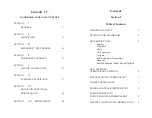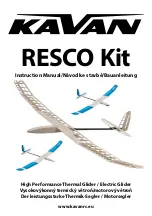
CESSNA
SECTION
4
MODEL 152
NORMAL PROCEDURES
1 July 1978
4-
19
1. VERIFY THAT AILERONS ARE NEUTRAL AND THROTTLE IS IN IDLE POSITION.
2. APPLY AND HOLD FULL RUDDER OPPOSITE TO THE DIRECTION OF ROTATION.
3. JUST AFTER THE RUDDER REACHES THE STOP, MOVE THE CONTROL WHEEL
BRISKLY FORWARD FAR ENOUGH TO BREAK THE STALL. Full down elevator may be
required at aft center of gravity loadings to assure optimum recoveries.
4. HOLD THESE CONTROL INPUTS UNTIL ROTATION STOPS. Premature relaxation of
the control inputs may extend the recovery.
5. AS ROTATION STOPS, NEUTRALIZE RUDDER, AND MAKE A SMOOTH RECOVERY
FROM THE RESULTING DIVE.
NOTE
If disorientation precludes a visual determination of the direction of
rotation, the symbolic airplane in the turn coordinator may be
referred to for this information.
Variations in basic airplane rigging or in weight and balance due to installed equipment or
cockpit occupancy can cause differences in behavior, particularly in extended spins. These
differences are normal and will result in variations in the spin characteristics and in the
recovery lengths for spins of more than 3 turns. However, the above recovery procedure
should always be used and will result in the most expeditious recovery from any spin.
Intentional spins with flaps extended are prohibited, since the high speeds which may occur
during recovery are potentially damaging to the flap/wing structure
LANDING
Normal landing approaches can be made with power-on or power-off at speeds of 60 to 70
KIAS with flaps up, and 55 to 65 KIAS with flaps down. Surface winds and air turbulence are
usually the primary factors in determining the most comfortable approach speeds.
Actual touchdown should be made with power-off and on the main wheels first. The nose
wheel should be lowered smoothly to the runway as speed is diminished.
SHORT FIELD LANDING
For a short field landing in smooth air conditions, make an approach at 54 KIAS with 301 flaps
using enough power to control the glide path. After all approach obstacles are cleared,
progressively reduce power and maintain 54 KIAS by lowering the nose of the airplane.
Touchdown should be made with power-off and on the main wheels first. Immediately after
touchdown, lower the nose wheel and apply heavy braking as required. For maximum brake
Summary of Contents for 152 1979
Page 8: ...CESSNA GENERAL MODEL 152 1 July 1978 1 2 Figure 1 1 Three View ...
Page 50: ...CESSNA SECTION 4 MODEL 152 NORMAL PROCEDURES 1 July 1978 4 12 ...
Page 62: ...CESSNA SECTION 5 MODEL 152 PERFORMANCE 1 July 1978 5 2 ...
Page 82: ...CESSNA SECTION 6 MODEL 152 WEIGHT BALANCE EQUIPMENT LIST 1 July 1978 6 2 ...
Page 87: ...CESSNA SECTION 6 MODEL 152 WEIGHT BALANCE EQUIPMENT LIST 1 July 1978 6 7 ...
Page 88: ...CESSNA SECTION 6 MODEL 152 WEIGHT BALANCE EQUIPMENT LIST 1 July 1978 6 8 ...
Page 94: ......
Page 95: ......
Page 96: ......
Page 97: ......
Page 98: ......
Page 99: ......
Page 100: ......
Page 104: ...CESSNA SECTION 7 MODEL 152 AIRPLANE SYSTEMS DESCRIPTIONS 1 July 1978 7 4 ...
Page 105: ...CESSNA SECTION 7 MODEL 152 AIRPLANE SYSTEMS DESCRIPTIONS 1 July 1978 7 5 ...
Page 106: ...CESSNA SECTION 7 MODEL 152 AIRPLANE SYSTEMS DESCRIPTIONS 1 July 1978 7 6 ...
Page 112: ...CESSNA SECTION 7 MODEL 152 AIRPLANE SYSTEMS DESCRIPTIONS 1 July 1978 7 12 ...
Page 120: ...CESSNA SECTION 7 MODEL 152 AIRPLANE SYSTEMS DESCRIPTIONS 1 July 1978 7 20 ...
Page 123: ...CESSNA SECTION 7 MODEL 152 AIRPLANE SYSTEMS DESCRIPTIONS 1 July 1978 7 23 ...
Page 128: ...CESSNA SECTION 7 MODEL 152 AIRPLANE SYSTEMS DESCRIPTIONS 1 July 1978 7 28 ...
Page 133: ...CESSNA SECTION 7 MODEL 152 AIRPLANE SYSTEMS DESCRIPTIONS 1 July 1978 7 33 ...
Page 137: ...CESSNA SECTION 8 MODEL 152 HANDLING SERVICE MAINTENANCE 1 July 1978 8 2 ...














































